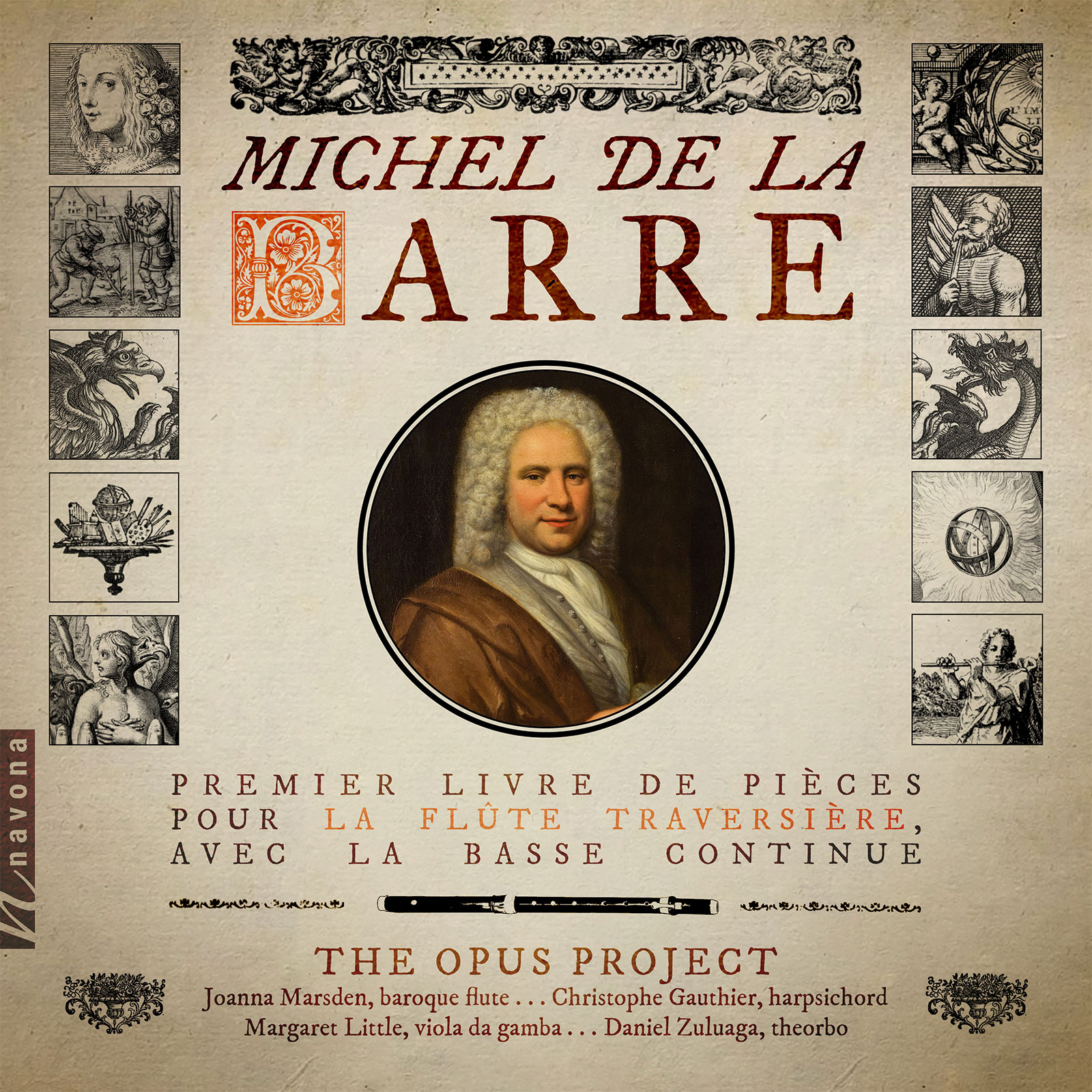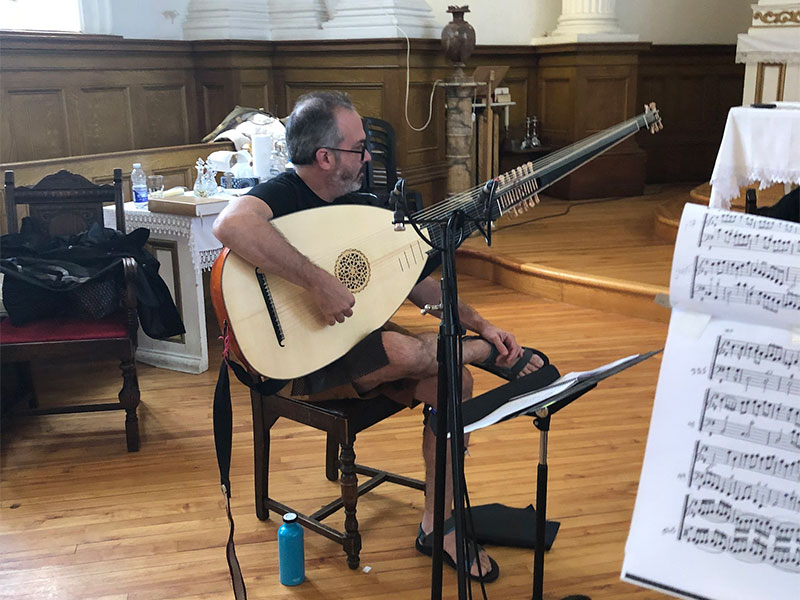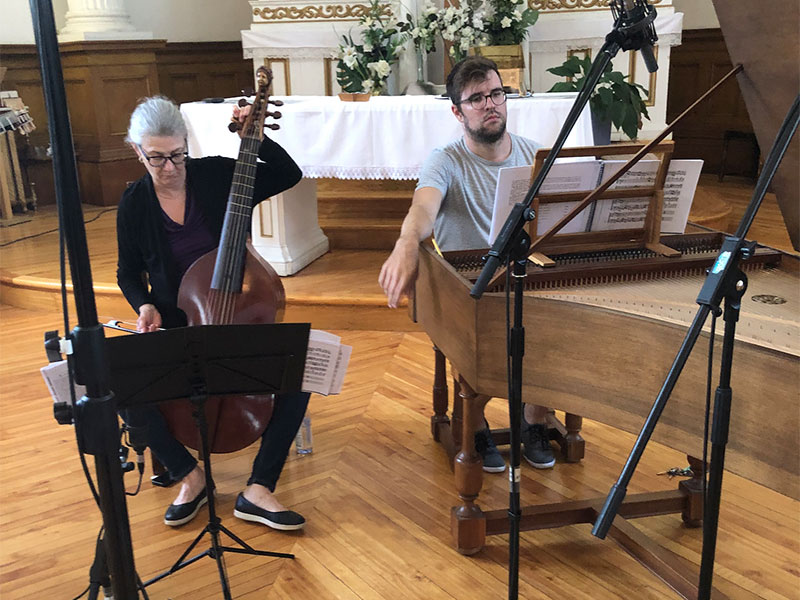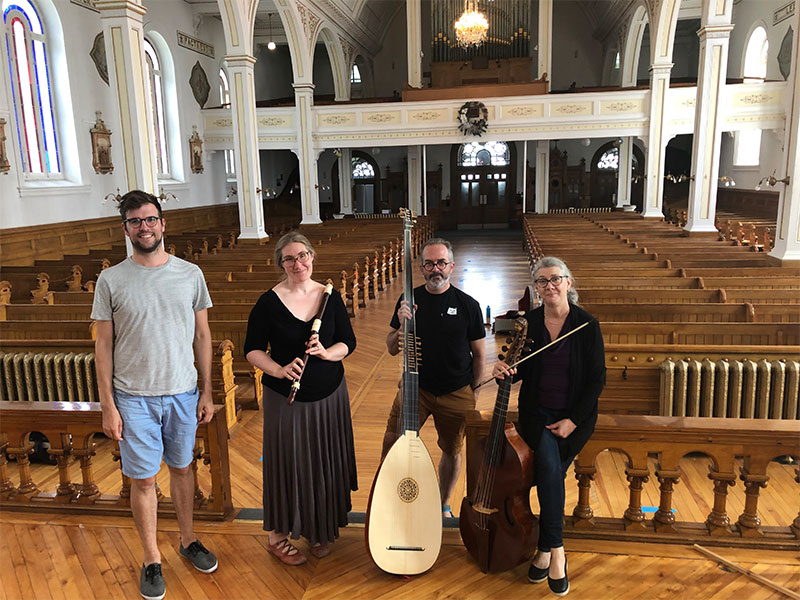Michel De La Barre
The Opus Project
Joanna Marsden baroque flute
Christophe Gauthier harpsichord
Margaret Little viola de gamba
Daniel Zuluaga theorbo
When four musicians of high caliber join forces, one can generally expect favorable results; but only the truly splendid manage to create a musical experience greater than the sum of its parts. Such is the nature of The Opus Project, founded in 2020 and already rated as one of Canada’s most eminent Early Music quartets.
On MICHEL DE LA BARRE, the four musicians masterfully perform rarely-heard, unsung suites by the eponymous French flute virtuoso and composer, who broke new ground in Baroque music by merit of being the first to publish solo pieces for his instrument. Zesty yet courtly, refined yet effervescent, these works please at once, not least owing to the lucid and charming interpretation by The Opus Project. A match made in heaven.
Listen
Stream/Buy
Choose your platform
Track Listing & Credits
| # | Title | Composer | Performer | |
|---|---|---|---|---|
| 01 | Suite I en D La Ré, Tierce Majeure: I. Prélude | Michel de la Barre | The Opus Project | Joanna Marsden, baroque flute; Christophe Gauthier, harpsichord; Margaret Little, viola da gamba; Daniel Zuluaga, theorbo | 1:48 |
| 02 | Suite I en D La Ré, Tierce Majeure: II. Allemande, l’Angelique. | Michel de la Barre | The Opus Project | Joanna Marsden, baroque flute; Christophe Gauthier, harpsichord; Margaret Little, viola da gamba; Daniel Zuluaga, theorbo | 2:58 |
| 03 | Suite I en D La Ré, Tierce Majeure: III. Air, le Badin. | Michel de la Barre | The Opus Project | Joanna Marsden, baroque flute; Christophe Gauthier, harpsichord; Margaret Little, viola da gamba; Daniel Zuluaga, theorbo | 1:35 |
| 04 | Suite I en D La Ré, Tierce Majeure: IV. Air, l’Espagnol. | Michel de la Barre | The Opus Project | Joanna Marsden, baroque flute; Christophe Gauthier, harpsichord; Margaret Little, viola da gamba; Daniel Zuluaga, theorbo | 0:51 |
| 05 | Suite I en D La Ré, Tierce Majeure: V. Gavotte, la Chevry. | Michel de la Barre | The Opus Project | Joanna Marsden, baroque flute; Christophe Gauthier, harpsichord; Margaret Little, viola da gamba; Daniel Zuluaga, theorbo | 1:17 |
| 06 | Suite I en D La Ré, Tierce Majeure: VI. Air, la Coquette. | Michel de la Barre | The Opus Project | Joanna Marsden, baroque flute; Christophe Gauthier, harpsichord; Margaret Little, viola da gamba; Daniel Zuluaga, theorbo | 1:20 |
| 07 | Suite I en D La Ré, Tierce Majeure: VII. Allemande, la Magdelon. | Michel de la Barre | The Opus Project | Joanna Marsden, baroque flute; Christophe Gauthier, harpsichord; Margaret Little, viola da gamba; Daniel Zuluaga, theorbo | 2:48 |
| 08 | Suite I en D La Ré, Tierce Majeure: VIII. Gigue, l’Angloise. | Michel de la Barre | The Opus Project | Joanna Marsden, baroque flute; Christophe Gauthier, harpsichord; Margaret Little, viola da gamba; Daniel Zuluaga, theorbo | 2:03 |
| 09 | Suite II en G Ré Sol, Tierce Majeure: I. Prélude | Michel de la Barre | The Opus Project | Joanna Marsden, baroque flute; Christophe Gauthier, harpsichord; Margaret Little, viola da gamba; Daniel Zuluaga, theorbo | 3:07 |
| 10 | Suite II en G Ré Sol, Tierce Majeure: II. Allemande, la Signora. | Michel de la Barre | The Opus Project | Joanna Marsden, baroque flute; Christophe Gauthier, harpsichord; Margaret Little, viola da gamba; Daniel Zuluaga, theorbo | 2:20 |
| 11 | Suite II en G Ré Sol, Tierce Majeure: III. Gigue, la Cadette. | Michel de la Barre | The Opus Project | Joanna Marsden, baroque flute; Christophe Gauthier, harpsichord; Margaret Little, viola da gamba; Daniel Zuluaga, theorbo | 0:59 |
| 12 | Suite II en G Ré Sol, Tierce Majeure: IV. Sarabande, l’aînée. | Michel de la Barre | The Opus Project | Joanna Marsden, baroque flute; Christophe Gauthier, harpsichord; Margaret Little, viola da gamba; Daniel Zuluaga, theorbo | 3:46 |
| 13 | Suite II en G Ré Sol, Tierce Majeure: V. Allemande, la Landais. | Michel de la Barre | The Opus Project | Joanna Marsden, baroque flute; Christophe Gauthier, harpsichord; Margaret Little, viola da gamba; Daniel Zuluaga, theorbo | 1:46 |
| 14 | Suite II en G Ré Sol, Tierce Majeure: VI. Rondeau, le Ninon. | Michel de la Barre | The Opus Project | Joanna Marsden, baroque flute; Christophe Gauthier, harpsichord; Margaret Little, viola da gamba; Daniel Zuluaga, theorbo | 1:00 |
| 15 | Suite II en G Ré Sol, Tierce Majeure: VII. Gavotte, la Therese & Double de la Gavotte. | Michel de la Barre | The Opus Project | Joanna Marsden, baroque flute; Christophe Gauthier, harpsichord; Margaret Little, viola da gamba; Daniel Zuluaga, theorbo | 1:42 |
| 16 | Suite II en G Ré Sol, Tierce Majeure: VIII. Rondeau, l’Etourdy. | Michel de la Barre | The Opus Project | Joanna Marsden, baroque flute; Christophe Gauthier, harpsichord; Margaret Little, viola da gamba; Daniel Zuluaga, theorbo | 2:26 |
| 17 | Suite II en G Ré Sol, Tierce Majeure: IX. Gigue, l’Ecossoise. | Michel de la Barre | The Opus Project | Joanna Marsden, baroque flute; Christophe Gauthier, harpsichord; Margaret Little, viola da gamba; Daniel Zuluaga, theorbo | 1:50 |
| 18 | Suite III en E Si Mi, Tierce Mineure: I. Prélude | Michel de la Barre | The Opus Project | Joanna Marsden, baroque flute; Christophe Gauthier, harpsichord; Margaret Little, viola da gamba; Daniel Zuluaga, theorbo | 3:15 |
| 19 | Suite III en E Si Mi, Tierce Mineure: II. Allemande, la Richelieu. | Michel de la Barre | The Opus Project | Joanna Marsden, baroque flute; Christophe Gauthier, harpsichord; Margaret Little, viola da gamba; Daniel Zuluaga, theorbo | 2:41 |
| 20 | Suite III en E Si Mi, Tierce Mineure: III. Caprice | Michel de la Barre | The Opus Project | Joanna Marsden, baroque flute; Christophe Gauthier, harpsichord; Margaret Little, viola da gamba; Daniel Zuluaga, theorbo | 1:32 |
| 21 | Suite III en E Si Mi, Tierce Mineure: IV. Gavotte, la Jolie. | Michel de la Barre | The Opus Project | Joanna Marsden, baroque flute; Christophe Gauthier, harpsichord; Margaret Little, viola da gamba; Daniel Zuluaga, theorbo | 0:39 |
| 22 | Suite III en E Si Mi, Tierce Mineure: V. Air, le Dragon. | Michel de la Barre | The Opus Project | Joanna Marsden, baroque flute; Christophe Gauthier, harpsichord; Margaret Little, viola da gamba; Daniel Zuluaga, theorbo | 1:06 |
| 23 | Suite III en E Si Mi, Tierce Mineure: VI. Rondeau, le Trianon. | Michel de la Barre | The Opus Project | Joanna Marsden, baroque flute; Christophe Gauthier, harpsichord; Margaret Little, viola da gamba; Daniel Zuluaga, theorbo | 1:21 |
| 24 | Suite III en E Si Mi, Tierce Mineure: VII. Allemande, la Montigny. | Michel de la Barre | The Opus Project | Joanna Marsden, baroque flute; Christophe Gauthier, harpsichord; Margaret Little, viola da gamba; Daniel Zuluaga, theorbo | 1:46 |
| 25 | Suite III en E Si Mi, Tierce Mineure: VIII. Rondeau, la Suédoise. | Michel de la Barre | The Opus Project | Joanna Marsden, baroque flute; Christophe Gauthier, harpsichord; Margaret Little, viola da gamba; Daniel Zuluaga, theorbo | 1:27 |
| 26 | Suite III en E Si Mi, Tierce Mineure: IX. Gigue, le Saint Maur. | Michel de la Barre | The Opus Project | Joanna Marsden, baroque flute; Christophe Gauthier, harpsichord; Margaret Little, viola da gamba; Daniel Zuluaga, theorbo | 1:24 |
| 27 | Suite IV en G Ré Sol, Tierce Mineure: I. Prélude | Michel de la Barre | The Opus Project | Joanna Marsden, baroque flute; Christophe Gauthier, harpsichord; Margaret Little, viola da gamba; Daniel Zuluaga, theorbo | 1:24 |
| 28 | Suite IV en G Ré Sol, Tierce Mineure: II. Allemande, la Florença. | Michel de la Barre | The Opus Project | Joanna Marsden, baroque flute; Christophe Gauthier, harpsichord; Margaret Little, viola da gamba; Daniel Zuluaga, theorbo | 2:55 |
| 29 | Suite IV en G Ré Sol, Tierce Mineure: III. Air, la Volage. | Michel de la Barre | The Opus Project | Joanna Marsden, baroque flute; Christophe Gauthier, harpsichord; Margaret Little, viola da gamba; Daniel Zuluaga, theorbo | 1:32 |
| 30 | Suite IV en G Ré Sol, Tierce Mineure: IV. Rondeau, le Flateur. | Michel de la Barre | The Opus Project | Joanna Marsden, baroque flute; Christophe Gauthier, harpsichord; Margaret Little, viola da gamba; Daniel Zuluaga, theorbo | 1:14 |
| 31 | Suite IV en G Ré Sol, Tierce Mineure: V. Allemande, la Nanette. | Michel de la Barre | The Opus Project | Joanna Marsden, baroque flute; Christophe Gauthier, harpsichord; Margaret Little, viola da gamba; Daniel Zuluaga, theorbo | 2:51 |
| 32 | Suite IV en G Ré Sol, Tierce Mineure: VI. Gigue, la Gijon. | Michel de la Barre | The Opus Project | Joanna Marsden, baroque flute; Christophe Gauthier, harpsichord; Margaret Little, viola da gamba; Daniel Zuluaga, theorbo | 1:21 |
| 33 | Suite IV en G Ré Sol, Tierce Mineure: VII. Allemande, la Princesse de Conty. | Michel de la Barre | The Opus Project | Joanna Marsden, baroque flute; Christophe Gauthier, harpsichord; Margaret Little, viola da gamba; Daniel Zuluaga, theorbo | 2:57 |
| 34 | Suite IV en G Ré Sol, Tierce Mineure: VIII. Gavotte, la Corine & Double de la Gavotte. | Michel de la Barre | The Opus Project | Joanna Marsden, baroque flute; Christophe Gauthier, harpsichord; Margaret Little, viola da gamba; Daniel Zuluaga, theorbo | 1:10 |
| 35 | Suite V en D La Ré, Tierce Mineure: I. Prélude | Michel de la Barre | The Opus Project | Joanna Marsden, baroque flute; Christophe Gauthier, harpsichord; Margaret Little, viola da gamba; Daniel Zuluaga, theorbo | 2:13 |
| 36 | Suite V en D La Ré, Tierce Mineure: II. Allemande, la Mariane. | Michel de la Barre | The Opus Project | Joanna Marsden, baroque flute; Christophe Gauthier, harpsichord; Margaret Little, viola da gamba; Daniel Zuluaga, theorbo | 2:51 |
| 37 | Suite V en D La Ré, Tierce Mineure: III. Rondeau, l’Affligé. | Michel de la Barre | The Opus Project | Joanna Marsden, baroque flute; Christophe Gauthier, harpsichord; Margaret Little, viola da gamba; Daniel Zuluaga, theorbo | 2:25 |
| 38 | Suite V en D La Ré, Tierce Mineure: IV. Allemande, la Villequiere. | Michel de la Barre | The Opus Project | Joanna Marsden, baroque flute; Christophe Gauthier, harpsichord; Margaret Little, viola da gamba; Daniel Zuluaga, theorbo | 2:32 |
| 39 | Suite V en D La Ré, Tierce Mineure: V. Gavotte, la Bagatelle. | Michel de la Barre | The Opus Project | Joanna Marsden, baroque flute; Christophe Gauthier, harpsichord; Margaret Little, viola da gamba; Daniel Zuluaga, theorbo | 0:33 |
| 40 | Suite V en D La Ré, Tierce Mineure: VI. Rondeau, le Provençal. | Michel de la Barre | The Opus Project | Joanna Marsden, baroque flute; Christophe Gauthier, harpsichord; Margaret Little, viola da gamba; Daniel Zuluaga, theorbo | 1:31 |
Recorded July 18-21, 2021 at Église Saint-Augustin in Mirabel, Québec, Canada
Recording Session Producer Noémy Gagnon-Lafrenais
Recording Session Engineer Philippe Bouvrette
Harpsichord Technician Jonathan Addleman
Program Notes Joanna Marsden
The Opus Project
Joanna Marsden, baroque flute
Reproduction of Hotteterre flute (Graz original) by Alain Weemaels, 2009.
Christophe Gauthier, harpsichord
German harpsichord by Yves Beaupré and Réjean Poirier, 1985.
Margaret Little, viola da gamba
Seven-string French bass viol after Colichon by Judith Kraft and Bernard Prunier, 1982.
Daniel Zuluaga, theorbo
Theorbo after Sebastian Schelle, Nürnberg (1728) by Lauri Niskanen, 2019.
Acknowledgements
We acknowledge the support of the Canada Council for the Arts. Nous remercions le Conseil des arts du Canada de son soutien.
![]()
With warm thanks to Église Saint-Augustin, Église Saint-Stanislas de Kostka, and Boaz Berney.
Executive Producer Bob Lord
Executive A&R Sam Renshaw
A&R Director Brandon MacNeil
A&R Danielle Lewis
VP of Production Jan Košulič
Audio Director Lucas Paquette
Mastering Melanie Montgomery
VP, Design & Marketing Brett Picknell
Art Director Ryan Harrison
Design Edward A. Fleming, Morgan Hauber
Publicity Patrick Niland, Aidan Curran
Content Manager Sara Warner
Artist Information
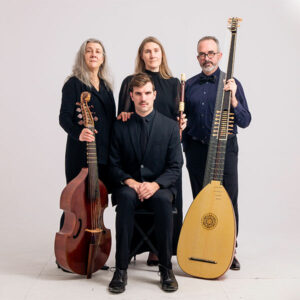
The Opus Project
The Opus Project is a chamber music initiative formed in 2020 in Montréal by Christophe Gauthier and Joanna Marsden. Inspired by the beauty of early musical prints and manuscript sources, the Opus Project explores unsung treasures of the baroque chamber music repertoire by focusing deeply on one collection at a time.
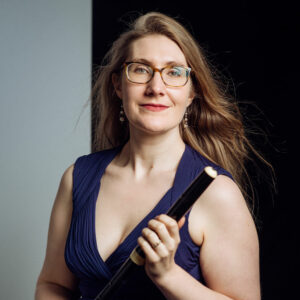
Joanna Marsden
Joanna Marsden is a “fabulous” (The Whole Note) flautist based in Montréal, Québec. She has performed with numerous ensembles throughout North America and Europe “beautifully” (Luis Gago, Madrid) and “with notable rhetorical clarity” (Boston Musical Intelligencer), and worked with conductors including Ton Koopman, Masaaki Suzuki, Václav Luks, Julian Prégardien, Mathieu Lussier, and Florian Heyerick, among others. She holds degrees from Vassar College, the Royal Conservatory of the Hague, and McGill University. She has offered engaging workshops and masterclasses to students throughout Europe and North America.
Christophe Gauthier
Montréal native Christophe Gauthier performs regularly with Arion baroque orchestra, Studio de musique ancienne de Montréal, the Ensemble Clavecin en concert, and the Orchestre Métropolitain under the direction of Yannick Nézet-Séguin. His talents as a chamber musician have led him to found ensembles including the Opus Project (Montréal), Rendez-vous baroque français (Montréal), la Frontera (Mexico), the Consort Laurentien (Basel), finalists at the York Early Music Festival Competition, and Fabulous Fringe performers at the Utrecht Early Music Festival. His main teachers include Réjean Poirier, Luc Beauséjour, and Mireille Lagacé with Benjamin Alard and Jory Vinikour.
Margaret Little
During the last four decades, Margaret Little has performed as a soloist and chamber musician on the viola da gamba and baroque viola with various Montréal-based and international ensembles. Little co-founded Les Voix humaines with Susie Napper in the 1980s and was artistic co-director until 2020. Les Voix humaines have toured the world, received critical acclaim and prestigious awards. Little has recorded over 100 CDs including two solo CDs, most of them for the ATMA label. She teaches the viola da gamba at Université de Montréal and has a private teaching studio.
Daniel Zuluaga
Theorbo, guitar, and lute player Daniel Zuluaga is a native of Colombia, where he began his musical education. His work has been praised for its “rhythmic vitality and a fine sense of color” (Washington Post) and lauded as “exemplary” and full of “great inventiveness” (San Francisco Classical Voice). Winner of Juno and Félix awards and GRAMMY Award nominee, he performs regularly with leading orchestras in the United States and Canada. An avid researcher, Zuluaga is a specialist in Latin American Baroque music. He holds a Ph.D. in musicology from the University of Southern California and has published articles on the history of the guitar.
Notes
Ainsi ta Flûte enchanteresse,
La Barre, inspire la Tendresse;
Tout s’enflamme à ses Sons Vainqueurs.
L’Amour même en devient plus tendre;
Et ne songeant plus qu’à t’entendre
Il te laisse blesser les cœurs.
— excerpt from La flûte: Ode à Monsieur de la Barre, fameux joueur de Flûte Allemande by Antoine Houdar de la Motte from Odes de Monsieur de la Motte de L’Académie françoise (Amsterdam: George Gallet, 1719)
The 18th-century theater historian Claude Parfaict described Michel de la Barre (c. 1675-1745) as the finest flute player of his age, particularly known for his deeply expressive playing. De la Barre’s collection, Premier livre de pièces pour la flute traversiere avec la basse-continue, was published in Paris in 1702. These are the earliest works for the baroque flute published in any country and were considered revolutionary in their context.
The son of a Paris wine merchant, de la Barre belonged to the generation of instrumentalists directly following the period of technical revolution in French woodwinds, during which the Renaissance flute was transformed into the one-keyed baroque flute. He studied with the first professional transverse flutists in France: René Pignon dit Descoteaux (c. 1645-1728) and Philibert Rebillé dit Philbert (1639-1717). Descoteaux and Philbert were multi-instrumentalists who played flute, musette, and oboe in various ensembles at court, notably the Menus Plaisirs and the Hautbois et Musettes de Poitou.
After this privileged education with Jean-Baptiste Lully’s preferred transverse flutists, de la Barre joined the orchestra of the Académie Royale by the beginning of the 18th century, and he became an official member of the exclusive petit choeur by 1713. By 1703, de la Barre entered officially into the Musique de l’Écurie et de la Chambre du Roi where he remained until 1730. De la Barre became a fixture in the salons of Versailles playing alongside François Couperin, Marais, Forqueray, and the Hotteterre brothers at the celebrated concerts for the couchers de roi.
A marker of de la Barre’s success is the iconic portrait by André Bouys held in the National Gallery in London that shows de la Barre guiding an informal reading of his music, including virtuoso viola da gambist Marin Marais with two seated flutists, perhaps Pierre Danican and Anne Danican Philidor. The flutists hold elegant three-part baroque flutes made of ivory and boxwood. Bouys took great care in the depiction of the sheet music on the table: a precise copy of de la Barre’s 1707 trios. The fine quality of this portrait suggests de la Barre’s high status as a composer at this time.
De la Barre was a prolific composer of both vocal music and instrumental music. His first collection of trio suites for violins, flutes, or oboes and continuo was published in 1694. His opéra-ballet, Le triomphe des arts, was published in 1700, and he received a privilege to publish his comédie-ballet, La vénitienne, in 1705. De la Barre also published several books of trios, songs, many suites for unaccompanied flutes, and two collections for flute and continuo.
De la Barre begins the preface to his Premier livre stating that he chose to publish these pieces because they have a character so singular and so different from what was previously considered appropriate to play on the flute. He may refer here to the change from contrapuntal polyphonic writing to the basso continuo style or to the changes to the flute which took place at the end of the 17th century as Renaissance instruments were replaced at court with sophisticated instruments made exclusively for art music.
The most obvious difference between the Renaissance flute and the baroque flute is the addition of a single key which allows access to all chromatic notes. The baroque flute’s conical bore makes all registers of the flute attractive. The low range of the cylindrical-bored Renaissance flute is comparatively much weaker and favors writing in the second octave. In his Premier livre, de la Barre’s music emphasizes the baroque flute’s strong, low register, even stretching below the flute’s normal compass in the Allemande la Mariane in his fifth suite. Surviving three-part instruments by the Naust and Hotteterre families generally play at a low pitch about a whole tone below modern concert pitch, which gives the flute a deep, rich tone and a noble expression.
De la Barre’s Premier livre contains five suites of varied character pieces all written in a common tonality. Many pieces in de la Barre’s suites are dance movements inspired by the belle danse popular at the court of Louis XIV. The majestic préludes which open each of de la Barre’s suites resemble the entrées graves in Lully’s operas, which were intricate dances usually performed by men.
De la Barre gave many movements a descriptive name either with an abstract character like la coquette, l’étourdy, le flateur, or l’affligé, or a real person or place. In his preface, he states that these pieces do not necessarily indicate anything about the character of the real people for whom they are named. Rather, he drew these names from the listeners who enjoyed these pieces or the places where he wrote them.
Surprisingly, de la Barre mentions that many movements can be performed without accompaniment. In terms of basso continuo instrumentation, he considers a viola da gamba with lute or harpsichord to be absolutely essential. He mentions that he prefers the sound of a lute’s gut strings with flute. The full complement of basso continuo instruments offers a lot of textural variety.
De la Barre also mentions that he included certain beautiful gestures and challenges in order to stimulate a rise in flute-playing standards, as Marin Marais had done with his compositions for the viola da gamba. In addition to the petits grâces or agréments peppering his music, de la Barre includes a few forms of transcribed ornamentation in several movements in his Premier livre. His gavottes La Therese and La Corine include an ornamented double, a complete ornamented reprise of the full movement. These doubles were inspired by the air de cour and brunette vocal genres in which composers like Le Camus, Boësset, Dembris, and Michel Lambert used florid ornamentation to accentuate the meaning of particular words in strophic songs. In other movements, the varied repetitions of his rondeau themes and suggested ornamentation demonstrate his elegant performance style inspired by French vocal improvisation. In turn, de la Barre’s music inspired vocalists: a parody of La Julie from his third suite was printed in Ballard’s Meslanges de Musique Latine, Françoise & Italienne in 1727 as C’est des beaux yeux de Julie.
While French baroque music from the early 18th century often negotiates the tension between the subtlety of French style as established by Lully and the passion and spontaneity of the Italian baroque style, de la Barre’s suites evoke other national styles. His L’espagnole, La signora, and La Gijon were likely inspired by de la Barre’s 1700 visit to Spain during a five-month tour in honor of the dukes of Burgundy and Berry. De la Barre’s designations of his gigues may indicate the English or Irish origins of this dance, but his gigue L’Ecossoise may be a nod to his close colleagues in the Philidor family, originally of Scottish extraction. His movements la Suedoise and la Provençale add further hints of exoticism.
As a performer, de la Barre was known for his particular talent with tender expression. Antoine Houdar de la Motte, who wrote the libretti for de la Barre’s La triomphe des arts and La Vénetienne, dedicated an ode to the famous flutist which described how his playing ignited the passions and inspired tender feelings. Pierre-Louis d’Aquin wrote in his Siècle litteraire de Louis XV (1753) that de la Barre had “the marvelous talent of touching his listeners, which is a gift of nature such that any kind of artifice will never achieve.”
Michel de la Barre’s Premier livre was published at a pivotal time for the flute which saw revolutionary changes in the physical instrument and its social context. These miniature character pieces combine many contrasts in expression, elegant dance rhythms, and a lot of good humor. The music is simple, pure, evocative, and often quite touching. Even the shortest movements are gems; each movement is integral to the whole tableau.
— Joanna Marsden
